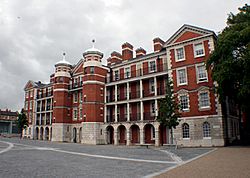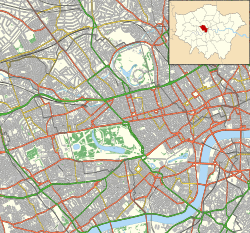Royal Army Medical College facts for kids
Quick facts for kids Royal Army Medical College |
|
|---|---|
| Millbank | |

Royal Army Medical College
|
|
|
Location within Westminster
|
|
| Coordinates | 51°29′25″N 0°07′44″W / 51.49039°N 0.12892°W |
| Type | Military College |
| Site information | |
| Owner | Ministry of Defence |
| Operator | |
| Site history | |
| Built | 1907 |
| Built for | War Office |
| In use | 1907-1999 |
The Royal Army Medical College (RAMC) was a special college in Westminster, London. It was located on Millbank, right by the River Thames. This college trained doctors and medical staff for the British Army. It closed in 1999. Today, the buildings are used by the Chelsea College of Arts. The area around the college is a protected historical site. The old college buildings are now considered important historical landmarks.
A Look Back: The College's History
The land where the college and the Tate Gallery (now called Tate Britain) stand used to be a prison. It was called Millbank Prison and was there from 1821 until the late 1800s.
The Royal Army Medical College was built in a grand style called Imperial Baroque. It was designed by John Henry Townsend and Wilfred Ainslie. They also designed the nearby buildings for officers and the Commandant's House. These were built in a French Renaissance style.
King Edward VII and Queen Alexandra officially opened the college on May 15, 1907. A statue of Sir James McGrigor, who is known as the "father of army medicine," was moved to the college grounds in 1907. Later, in 2000, it was moved again to the Royal Military Academy Sandhurst.
A hospital called Queen Alexandra Military Hospital was built nearby. It opened in 1905. Sir Cooper Perry was honored for helping to set up the college.
The College During Wartime
During the First World War, the college played a very important role. Scientists there worked on making vaccines. They even developed a vaccine to fight typhoid, a serious illness. The college also researched how to protect soldiers from chemical attacks. They helped develop gas masks to keep soldiers safe.
In the Second World War, the college taught doctors about tropical medicine. This was important for soldiers fighting in hot climates. The college buildings were badly damaged by bombs in 1941. You can still see signs of this damage on the walls of the nearby Tate Gallery.
Changes and Closure
In April 1996, the Royal Army Medical College became part of the Royal Defence Medical College. It focused on training doctors who had already finished their basic medical studies.
In 1999, the teaching moved to the Royal Hospital Haslar in Gosport. After that, the Royal Army Medical College closed its doors. The buildings then became home to the Chelsea College of Arts, which is an art school.



